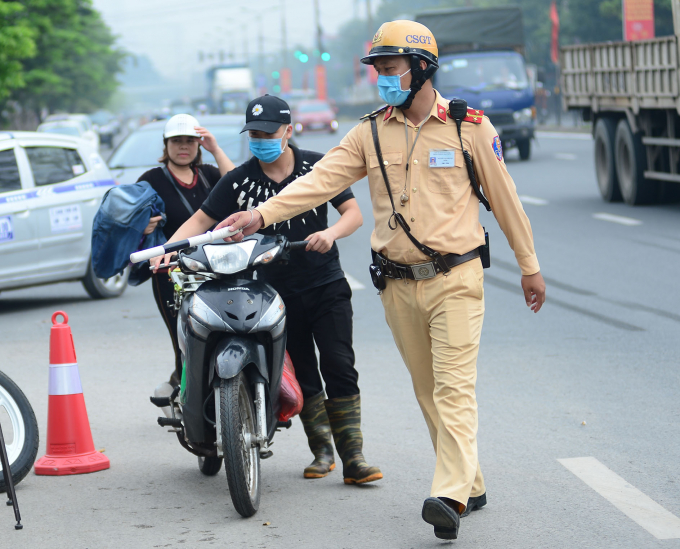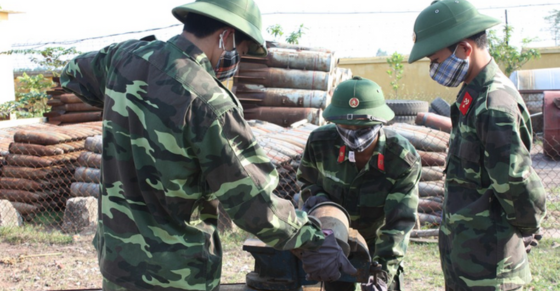Signal to stop vehicles in Vietnam according to Circular 32
What are the regulations on signal to stop vehicles in Vietnam according to Circular 32? - Duy Khuong (Binh Thuan)

Signal to stop vehicles in Vietnam according to Circular 32 (Internet image)
Regarding this issue, LawNet would like to answer as follows:
1. Signal to stop vehicles in Vietnam according to Circular 32
According to Article 17, Circular 32/2023/TT-BCA stipulates the order to stop vehicles as follows:
(1) The Traffic Police's order to stop a vehicle is made through one of the following signals or a combination of the following signals simultaneously:
- Traffic command sticks, horns, speakers, and priority signals for patrol and control vehicles;
- Other signals as prescribed by law, including: signs, marker posts, and fences.
(2) Signal to stop the vehicle when controlling at a point on the road, at the Traffic Police Station
- Traffic Police officers choose a suitable position, stand at attention, facing the vehicle that needs to be controlled, and signal to stop the vehicle at a safe distance; The right hand holds the traffic command stick and points it at the vehicle that needs to be controlled. At the same time, blow the whistle decisively, instructing the driver of the vehicle that needs to be controlled to stop in a suitable and safe position for control;
- When receiving the signal, the vehicle driver must slow down and stop the vehicle in a certain position according to the instructions of the Traffic Police.
(3) Signaling to stop a vehicle while sitting on a patrol or mobile control vehicle
- In case the patrol and control vehicles are going in the same direction and in front of the vehicle that needs to be controlled
Traffic Police officers hold a traffic command stick and move it horizontally to the right or left side of the patrolling and controlling vehicle (depending on the part of the road and lane where the vehicle needs to be controlled). then bring it up vertically, perpendicular to the ground; Use horns and speakers, give priority signals to patrol and control vehicles, and guide drivers of vehicles that need to be controlled to stop in appropriate, safe locations for control. When receiving the signal, the vehicle driver must slow down and stop the vehicle in a position according to the instructions of the Traffic Police officer;
- In case the patrol and control vehicles are going in the same direction and behind the vehicle that needs to be controlled
Traffic Police officers use loudspeakers to broadcast priority signals to patrol and control vehicles and instruct drivers of vehicles that need to be controlled to stop in appropriate, safe locations for control.
In case of necessity, if safety is ensured, patrol and control vehicles can pass in front of the vehicle that needs to be controlled and execute the command to stop the vehicle according to the provisions of Point a, Clause 3, Article 17 of Circular 32/2023/TT-BCA. When receiving the signal, the vehicle driver must slow down and stop the vehicle in a position according to the instructions of the Traffic Police officer.
2. Cases where traffic vehicles are stopped for control
Pursuant to Clause 1, Article 16 of Circular 32/2023/TT-BCA stipulates that Traffic Police officers performing patrol and control tasks according to plan are allowed to stop vehicles for control in the following cases:
- Directly detecting or, through means and professional technical equipment, detecting and collecting violations of road traffic laws and other violations of law;
- Implementing orders and plans for total vehicle control to ensure road traffic order, safety, and social order; Plans for patrolling, controlling, and handling violations according to topics to ensure order, road traffic safety, and social order have been promulgated by competent authorities;
- There is a written request from the Head or Deputy Head of the investigation agency; Written request from relevant authorities to stop traffic vehicles for control to ensure security and order; fight against crime; prevent and fight natural disasters, fires, and explosions; prevent and control disease; rescue, rescue, and other illegal acts. The written request must specify the time, route, means of transport stopped for control and handling, and the forces involved in coordination;
- There are reports, recommendations, and denunciations from organizations and individuals about violations of the law by people and vehicles participating in road traffic.
Ho Quoc Tuan
- Key word:
- vehicles
- in Vietnam
- Cases of land rent exemption and reduction under the latest regulations in Vietnam
- Economic infrastructure and social infrastructure system in Thu Duc City, Ho Chi Minh City
- Regulations on ordination with foreign elements in religious organizations in Vietnam
- Increase land compensation prices in Vietnam from January 1, 2026
- Determination of land compensation levels for damage during land requisition process in Vietnam
- Who is permitted to purchase social housing according to latest regulations in Vietnam?
-

- Emergency response and search and rescue organizations ...
- 10:29, 11/09/2024
-

- Handling of the acceptance results of ministerial ...
- 09:30, 11/09/2024
-

- Guidance on unexploded ordnance investigation ...
- 18:30, 09/09/2024
-

- Sources of the National database on construction ...
- 16:37, 09/09/2024
-

- General regulations on the implementation of administrative ...
- 11:30, 09/09/2024
-

- Notable new policies of Vietnam effective as of ...
- 16:26, 11/04/2025
-
.Medium.png)
- Notable documents of Vietnam in the previous week ...
- 16:21, 11/04/2025
-
.Medium.png)
- Notable documents of Vietnam in the previous week ...
- 16:11, 02/04/2025
-
.Medium.png)
- Notable new policies of Vietnam to be effective ...
- 16:04, 02/04/2025
-
.Medium.png)
- Notable new policies of Vietnam effective from ...
- 14:51, 21/03/2025
 Article table of contents
Article table of contents
